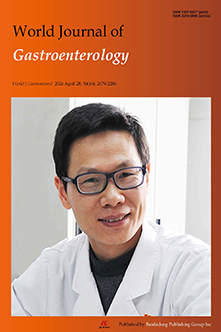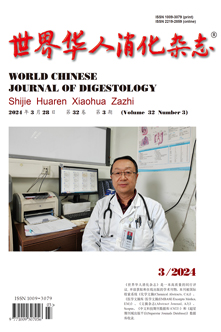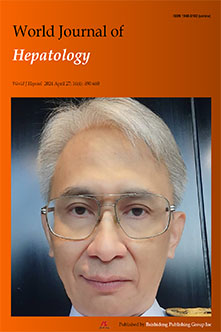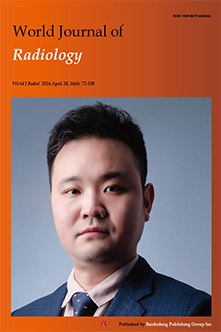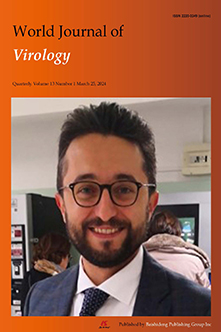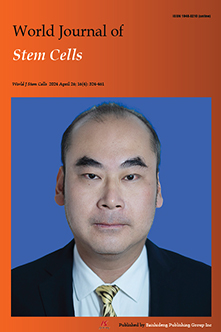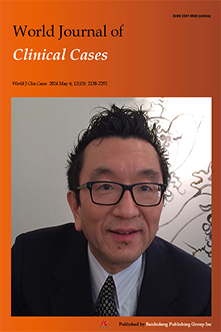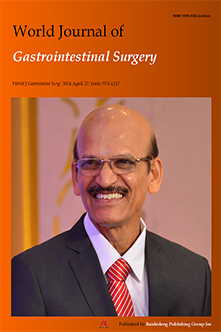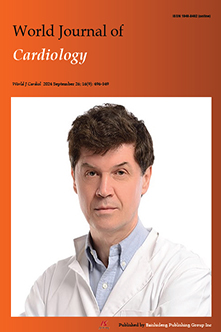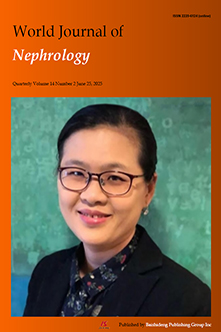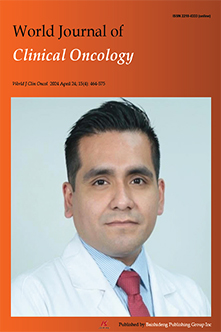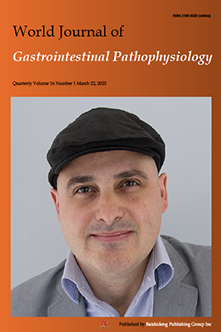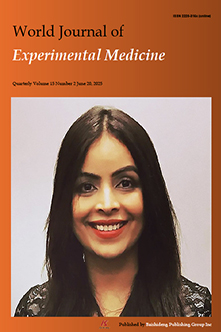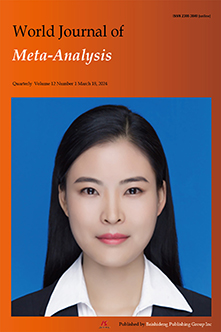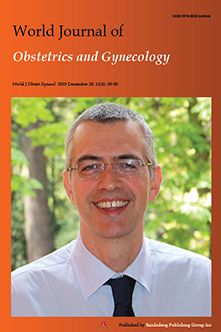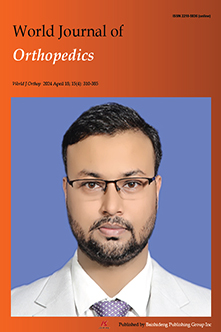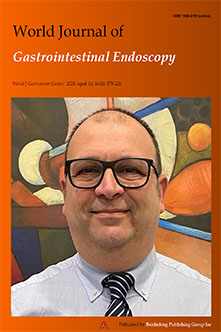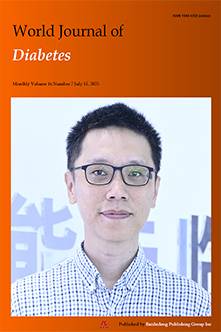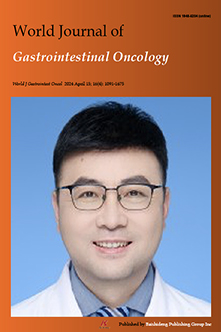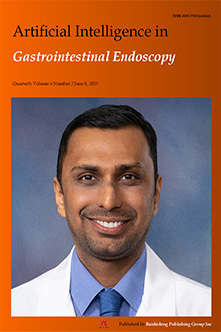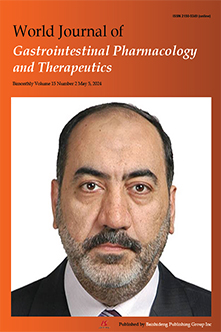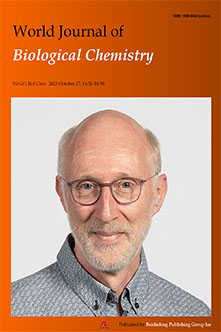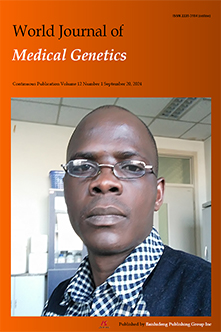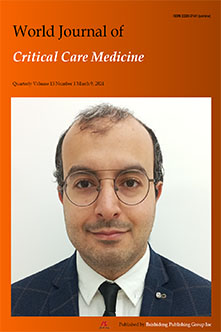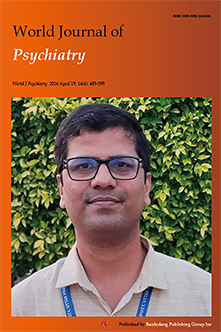Publisher Login
Manuscript Statistics
1
2
3
4
5
6
7
8
2025-12-26 | Browse: 10 | Download: 0
9
10
2025-12-26 | Browse: 7 | Download: 0
11
2025-12-26 | Browse: 10 | Download: 0
12
13
2025-12-26 | Browse: 3 | Download: 0
14
15
16
17
2025-12-25 | Browse: 32 | Download: 0
18
19
20
773 items Read more >>
1
"An excellent process from submission to publication of article. The paper received a very fast processing from the submission to the ..."
[Read more]
"An excellent process from submission to publication of article. The paper received a very fast processing from the submission to the peer review. The final version of the paper is exactly as the authors wished. We believe that the journal should be considered carefully from all researchers, and especially, for radioanatomical study for potential submissions. We are really pleased that our study was published to World Journal of Radiology. "
[Collapse]
Triantafyllou G, Papadopoulos-Manolarakis P, Arkoudis NA, Moschovaki-Zeiger O, Velonakis G, Piagkou M. Magnetic resonance imaging-based classification of trigeminal nerve-superior cerebellar artery relationships. World J Radiol 2025; 17(12): 116453
2
"It is always a pleasure to work together with the BPG, and I am excited for further publications in the future. Relative to other ..."
[Read more]
"It is always a pleasure to work together with the BPG, and I am excited for further publications in the future. Relative to other journals, the process from submission to publication is fast most of the time. Peer review reports are usually helpful and constructive. Keep up the excellent work. "
[Collapse]
Arkoudis NA, Siderakis M, Tsetsou I, Efthymiou E, Triantafyllou G, Chalmoukis D, Karachaliou A, Papadopoulos A, Prountzos S, Moschovaki-Zeiger O, Gouliopoulos N, Papakonstantinou O, Filippiadis D, Velonakis G. Developmental venous anomalies and cerebral cavernous malformations: Partners in crime. World J Radiol 2025; 17(12): 114595
3
"The submission process went smoothly. I am grateful to the editor and the reviewers for their assistance. During the submission ..."
[Read more]
"The submission process went smoothly. I am grateful to the editor and the reviewers for their assistance. During the submission process, through communication with the editor and the reviewers, I learned a lot of knowledge. I also gained a lot of insights into the writing of the article, the creation of tables and figures, etc. This will be of great help for future research. I hope there will be more cooperation in the future. "
[Collapse]
Cai B, Qiao ML, Miao D, Liu GZ. Cardiac myxoma and its implications for cardioembolic stroke. World J Cardiol 2025; 17(12): 112396
4
"All comments and suggestions provided by the reviewers and the editorial team have been carefully considered. In response to their ..."
[Read more]
"All comments and suggestions provided by the reviewers and the editorial team have been carefully considered. In response to their constructive feedback, we have revised the manuscript and made the necessary corrections and improvements. Particular attention has been given to the methodology, discussion, and overall clarity of presentation. We believe that this revision process has significantly enhanced the scientific contribution and quality of the paper. We sincerely thank the reviewers and editors for their valuable time and insightful comments. "
[Collapse]
Öndeş B, Gökdere OG, Kanat BH. Effect of resected gastric volume on weight loss after sleeve gastrectomy: A retrospective clinical study. World J Gastrointest Surg 2025; 17(12): 113571
5
"We would like to share some constructive feedback regarding our experience with the editorial process. On this occasion, the process ..."
[Read more]
"We would like to share some constructive feedback regarding our experience with the editorial process. On this occasion, the process was efficient and relatively fast, which we truly appreciate. However, in previous submissions we have experienced considerably longer response times, which can be challenging for authors, particularly when revisions are time-sensitive. Another aspect we have noticed, both in this journal and within the same editorial group, is that minor revision requests are sometimes communicated in multiple rounds. It might be helpful to consolidate all minor comments into a single revision round whenever possible, as this would streamline the process and reduce repeated back-and-forth communications. Finally, we observed that several formal and administrative requirements are requested during the review and revision stages. While we fully understand their importance, some of these requirements might be more efficiently requested after a manuscript has been formally accepted, rather than during the peer-review process. We share these comments in a constructive spirit, with the aim of contributing to an even more efficient and author-friendly editorial workflow. "
[Collapse]
Ramos-Gregorio CO, Tremillo-Maldonado O, Silveira F, Schuch LF, Pereira-Prado V, Sicco E, Soto-Najera AC, GómezPalacio-Gastélum M, Isiordia-Espinoza M, Muñoz-Ibarra JJ, Toral-Rizo V, Bologna-Molina R. Multifocal epithelial hyperplasia: Clinical features, diagnosis and management challenges. World J Exp Med 2025; 15(4): 114368
6
"We appreciate the opportunity to submit our work to F6 Publishing. The process was overall easy to manage, but the submission page ..."
[Read more]
"We appreciate the opportunity to submit our work to F6 Publishing. The process was overall easy to manage, but the submission page had a few glitches without well-explained error messages. We also waited several months from article acceptance to article publication. However, the peer review comments were valuable for improving our final manuscript. "
[Collapse]
Hutchinson HJ, Gonzalez M, Feier D, Welch CE, Lucke-Wold B. Colorectal cancer metastasis to the brain: A scoping review of incidence, treatment, and outcomes. World J Gastrointest Pathophysiol 2025; 16(4): 110961
7
"As the corresponding author of this manuscript, I would like to express my high level of satisfaction with the entire submission and ..."
[Read more]
"As the corresponding author of this manuscript, I would like to express my high level of satisfaction with the entire submission and publication process. The editorial team demonstrated rigor, efficiency, and professionalism throughout all stages of manuscript handling: The online submission system was user-friendly and well-structured, with timely updates on manuscript status, greatly facilitating progress tracking. The peer review process was not only reasonably timed but also provided detailed and constructive feedback. The reviewers offered valuable suggestions regarding study design, data interpretation, and academic expression, which substantially enhanced the scholarly quality and logical coherence of the paper. The editing and production quality was commendable, with professional language polishing, clear formatting of figures and tables, and final PDF and online versions that fully met academic publishing standards. The publication workflow was transparent and well-organized, with a reasonable timeframe from acceptance to online publication, aligning with the timeliness required for academic dissemination. The journal’s academic norms and ethical guidelines were clearly communicated, and the editorial office proactively provided relevant guidelines and conducted plagiarism checks, reflecting the journal’s strong commitment to academic integrity. Overall, the journal excels in academic services, publication quality, and author support, demonstrating a strong academic reputation and professional standards. I would gladly recommend this journal to my peers and look forward to future collaborations. "
[Collapse]
Ma HY, Chen YW, Liu X, Zhang MM, Tan BB. Modified Pingwei Baohe decoction improves postoperative recovery in gastric cancer patients. World J Gastrointest Surg 2025; 17(12): 113364
8
"It has been such a pleasant experience submitting our work to your journal. The reviewers provided insightful suggestions that truly ..."
[Read more]
"It has been such a pleasant experience submitting our work to your journal. The reviewers provided insightful suggestions that truly enhanced the quality of the manuscript. Your editorial team's dedication and efficiency are truly commendable. We are already looking forward to the opportunity of contributing to your esteemed journal again in the future. "
[Collapse]
Gong L, Yu J, Lv ZB, Qin XZ, Li M, Guo W, Huang B, Tian YH. Reducing anastomotic complications with endoscopy in laparoscopic total gastrectomy. World J Gastrointest Surg 2025; 17(12): 114079
9
"We sincerely thank the reviewers for their insightful comments and the editor for effectively facilitating the review process. The ..."
[Read more]
"We sincerely thank the reviewers for their insightful comments and the editor for effectively facilitating the review process. The constructive feedback significantly enhanced the quality of our manuscript. While we appreciate the academic rigor, we believe the overall publication period could be shorter to ensure more timely dissemination. We are grateful for the editorial team's support and the professional handling of our submission throughout this period. "
[Collapse]
Katsaros I, Papadakos SP, Despotidis M, Koutsoumpas A, Schizas D. Endoscopic vacuum-assisted closure as a first-line treatment for post-esophagectomy anastomotic leaks: A paradigm shift in management. World J Gastrointest Surg 2025; 17(12): 113305
10
"I am happy to provide the author’s comments for our submission to World Journal of Gastrointestinal Pathophysiology. The process of ..."
[Read more]
"I am happy to provide the author’s comments for our submission to World Journal of Gastrointestinal Pathophysiology. The process of submission is efficient. The authors feel well supported. The peer review was very helpful. Overall, the experience from submission to publication was good. I am thankful to the journal editing and production team. "
[Collapse]
Dutta AK, Vishruth S, Kovi SL, Dadhich P, Polavarapu J, Abraham D. Gut microbiota as a potential predictor of therapeutic response in adults with Crohn’s disease: A systematic review. World J Gastrointest Pathophysiol 2025; 16(4): 112961
11
"I have no extra comments or suggestions regarding the peer-review report, the second decision report of the editorial boards, and ..."
[Read more]
"I have no extra comments or suggestions regarding the peer-review report, the second decision report of the editorial boards, and the review comments of the track the quality and reader’s comments of your article after publication. I feel good on the whole process of editing and publishing. Thank you for the invitation for this manuscipt, and for waiveing the publication costs for this Letter to the Editor. "
[Collapse]
Jing C, Liu K. Taming colonic anastomotic leakage: Wisdom from the ancient Chinese legend of Yu the Great. World J Gastrointest Surg 2025; 17(12): 113423
12
"I would like to express my satisfaction with the overall review and evaluation process of our paper, which was conducted professionally ..."
[Read more]
"I would like to express my satisfaction with the overall review and evaluation process of our paper, which was conducted professionally and transparently. My only minor observation is that the publication process took somewhat longer than than I expected (the article was fully accepted on September 15, 2025, but not published until December 27, 2025). However, this is more of a remark than a complaint, as I understand the operational challenges that journals sometimes face. I wish to emphasize that I have no serious concerns regarding the quality or handling of the submission process. Thank you to the journal and the reviewers for their time and effort devoted to our work. Sincerely, Enver Zerem, Corresponding Author "
[Collapse]
Zerem E, Jovanovic P, Kunosic S, Kurtcehajic A, Zerem D, Zerem O. Optimal timing of pyogenic liver abscess evacuation: The role of early ultrasound-guided intervention. World J Gastrointest Surg 2025; 17(12): 110644
13
"I am delighted to share that my paper, Very early recurrence after pancreatic cancer resection: Unmasking the "biological R2" enigma ..."
[Read more]
"I am delighted to share that my paper, Very early recurrence after pancreatic cancer resection: Unmasking the "biological R2" enigma and rethinking prognostic paradigms, has been officially published in the World Journal of Gastrointestinal Surgery. First and foremost, I would like to express my sincere gratitude to my supervisor for their invaluable guidance, rigorous academic insights, and constant encouragement throughout the research and writing process. Their mentorship was pivotal to the completion of this work. I am also deeply thankful to my co-authors for their dedicated collaboration, as well as to all the research team members who contributed to data collection, experiments, and discussions. This achievement would not have been possible without our joint efforts. My appreciation also goes to the anonymous reviewers for their constructive comments and thoughtful suggestions, which greatly enhanced the quality and rigor of the paper. I would like to extend my thanks to the editorial team of the World Journal of Gastrointestinal Surgery for their professionalism, efficiency, and patience during the peer-review and publication process. Finally, I am grateful to the funding agencies and institutions that supported this research, as well as to my family and friends for their unwavering support and understanding. I hope this paper can make a modest contribution to the advancement of pancreatic cancer treatment, and I look forward to further academic exchanges and collaborations with colleagues in the field. "
[Collapse]
Wan P, Zhou SQ, Ke QH. Very early recurrence after pancreatic cancer resection: Unmasking the "biological R2" enigma and rethinking prognostic paradigms. World J Gastrointest Surg 2025; 17(12): 114403
14
"Author’s Comments*: The figure submission process was unnecessarily cumbersome and time-consuming. We hope the journal could streamline ..."
[Read more]
"Author’s Comments*: The figure submission process was unnecessarily cumbersome and time-consuming. We hope the journal could streamline the workflow and adopt a more author-friendly policy that prioritizes scientific clarity over rigid format requirements. Specifically, if figures meet clear, objective standards for readability and resolution, authors should be able to submit them in a wider range of common formats without extensive reformatting or repeated technical checks. This would improve submission efficiency and reduce administrative burden while maintaining the quality of published visuals. "
[Collapse]
Li H, Li ZP, Zhu MT, Lan CH, Wang YX, Liao P, Chen Z, Wang P, Sun JK, Shi Z, Lu PY, Lou C, Xu GH. Optimizing mesenchymal stem cell therapy for tendon-bone healing: Multifaceted approaches and future directions. World J Stem Cells 2025; 17(12): 114076
15
"Word Journal of Cardiovascular is a specialized academic journal focused on the field of cardiovascular medicine. It primarily ..."
[Read more]
"Word Journal of Cardiovascular is a specialized academic journal focused on the field of cardiovascular medicine. It primarily publishes high-quality original research, review articles, and case reports, aiming to advance scholarly exchange and clinical practice in this discipline. The journal is typically overseen by an editorial board comprising recognized experts, and it maintains a rigorous peer-review process to ensure the academic validity and reliability of its published content. "
[Collapse]
Wang LF, Zhu HJ, Wang C, Yan F, Qu CZ. Logistic regression-based risk prediction of aortic adverse remodeling following thoracic endovascular aortic repair in patients with aortic dissection. World J Cardiol 2025; 17(12): 112978
16
"We sincerely thank the editorial team for their efficient and constructive handling of our manuscript. The reviewers' comments were ..."
[Read more]
"We sincerely thank the editorial team for their efficient and constructive handling of our manuscript. The reviewers' comments were insightful, and the editorial team's clear communication was invaluable in strengthening the final paper. We are grateful for the professionalism and support throughout the entire publication process. We are mitivated to publish more in this journal. "
[Collapse]
Mulate ST, Gesese BD, Nur AM, Mengistu HB, Annose RT, Berga AE, Ulfata AL. Hepatic fascioliasis of emphasizing diagnostic difficulty and the need for high index of suspicion: Four case reports. World J Clin Cases 2025; 13(36): 113778
17
"Thank you very much to the editorial team for the smooth workflow throughout the publication process. The peer reviewers’ comments ..."
[Read more]
"Thank you very much to the editorial team for the smooth workflow throughout the publication process. The peer reviewers’ comments were valuable and helped improve the manuscript. One possible area for improvement would be avoiding repeated requests for an English Language Certificate after clarification that all authors are native English speakers. "
[Collapse]
Kim Y, See KC. Constipation in critically ill adults. World J Gastrointest Pathophysiol 2025; 16(4): 112019
18
"The authors of this manuscript were highly satisfied with their publication experience at the World Journal of Nephrology. Throughout ..."
[Read more]
"The authors of this manuscript were highly satisfied with their publication experience at the World Journal of Nephrology. Throughout the submission, peer-review, and editorial processes, communication was professional, timely, and constructive, contributing meaningfully to the quality of the final manuscript. We sincerely appreciate the rigour and transparency of the editorial handling and the valuable feedback provided by the reviewers. We look forward to future opportunities for collaboration with the journal and would be pleased to consider the World Journal of Nephrology for our forthcoming work. "
[Collapse]
Haddiya I, Simanjuntak GDFI, Ramdani S. Updates in the management of intradialytic hypotension: Emerging strategies and innovations. World J Nephrol 2025; 14(4): 109168
19
"On behalf of all the authors, I would like to express our sincere gratitude for the overall publication process. We are truly delighted ..."
[Read more]
"On behalf of all the authors, I would like to express our sincere gratitude for the overall publication process. We are truly delighted with the constructive and insightful feedback provided during the peer-review stage, which significantly enhanced the quality and clarity of our manuscript. Furthermore, we are extremely pleased with the final product and the professional presentation of our work. The efficiency and support of the editorial team have made this a very positive experience, and we are confident that we will choose this journal again for our future research submissions. "
[Collapse]
Gargallo-Bayo P, Rodrigo-Mallorca D, Calatayud J, Suso-Martí L, Vicent-Micó J, Chulvi-Medrano I. Examining the impact of blood flow restriction on cardiac rehabilitation outcomes. World J Cardiol 2025; 17(12): 111591
20
"I am highly impressed with your journal in multiple aspects. First and foremost, the processing speed is exceptionally efficient—from ..."
[Read more]
"I am highly impressed with your journal in multiple aspects. First and foremost, the processing speed is exceptionally efficient—from submission to publication, every stage proceeds smoothly without unnecessary delays. The submission system is intuitive and user-friendly, making the entire process seamless and hassle-free. Moreover, the peer review process stands out for its promptness and high quality: the reviewers provided insightful, constructive comments that greatly enhanced the rigor of my manuscript. Following acceptance, the publication process was equally expeditious, which I truly appreciate. Overall, I am thoroughly satisfied with every dimension of your journal’s services. Thank you for your professional and diligent work throughout the entire publishing journey. "
[Collapse]
Guan KY, Wu QZ, Ning B, Ling-Hu EQ. Exploration of a new method of a biopatch based on the central concept of the multi-layer repair. World J Gastrointest Surg 2025; 17(12): 113490
20337 items Read more >>
1
"Bouveret syndrome is a rare form of gallstone ileus, presenting as gastric outlet obstruction due to a large gallstone that has ..."
[Read more]
"Bouveret syndrome is a rare form of gallstone ileus, presenting as gastric outlet obstruction due to a large gallstone that has migrated through a biliogastric or bilioduodenal fistula.This manuscript is a well-written and presented rarely case report.Bouveret Syndrome primarily affects elderly patients. The authors point out that it may also occur in young individuals. I think that this manuscript is worth to publication."
[Collapse]
Hu YC, Chen XY, Cao MK, Fan Z. Bouveret syndrome in a young patient: A case report and review of literature. World J Gastrointest Surg 2025; 17(12): 113532
2
"This study clearly highlights the importance and contribution of AI in the diagnosis of rectal neuroendocrine tumors in daily clinical ..."
[Read more]
"This study clearly highlights the importance and contribution of AI in the diagnosis of rectal neuroendocrine tumors in daily clinical practice. It is known that rectal endocrine tumors present significant diagnostic difficulties because they are often considered as hyperplastic polyps and are either not removed and therefore not subjected to histological evaluation, or are removed as normal polyps. The consequence is that diagnosis is delayed or requires subsequent complementary imaging and/or endoscopic examination.
The authors developed an image analysis and detection model for rectal neuroendocrine tumors using the YOLOv7 algorithm. This algorithm demonstrated significant diagnostic accuracy, exceeding that of most endoscopes with which it was compared.
It has been repeatedly emphasized that AI is expected to revolutionize the diagnosis of many gastrointestinal diseases, including rectal endocrine tumors. We experience this to a large extent in daily clinical practice. However, it should be emphasized that the effectiveness of this system in detecting neuroendocrine rectal tumors should be investigated and evaluated in future large, multicenter studies."
[Collapse]
Liu K, Wang ZY, Yi LZ, Li F, He SH, Zhang XG, Lai CX, Li ZJ, Qiu L, Zhang RY, Wu W, Lin Y, Yang H, Liu GM, Guan QS, Zhao ZF, Cheng LM, Dai J, Bai Y, Xie F, Zhang MN, Chen SZ, Zhong XF. Artificial intelligence-assisted diagnosis of rectal neuroendocrine tumors during white-light endoscopy. World J Gastroenterol 2025; 31(48): 112683
3
"1. The authors have projected the cardiotoxicity as a sequel of chemotherapy relevant to LMIC in perspective, documenting the follow ..."
[Read more]
"1. The authors have projected the cardiotoxicity as a sequel of chemotherapy relevant to LMIC in perspective, documenting the follow up timings
2. The importance of the follow up and its necessity is also well brought out in the light of current literature
3. The relevance of cardiotoxicity lies in the drug / regime and the dosage. Especially if the patient was administered more than the expected maximal dosage. This can be included for better understanding. "
[Collapse]
Ali W, Mehmood A, Surani S. Chemotherapy-related cardiotoxicity: Bridging the gap between evidence and practice. World J Clin Cases 2025; 13(36): 114228
4
"1. The difference of a squamous cell ca in a viscera, in comparison to that in the superficial skin site can be brought out in terms ..."
[Read more]
"1. The difference of a squamous cell ca in a viscera, in comparison to that in the superficial skin site can be brought out in terms of presentation, prognosis / management / tumor behaviour, etc
2. When to suspect a similar lesion can be highlighted for the benefit of readers
3. The conclusion section can avoid summary of the manuscript, rather can include a crisp take home message on the index case."
[Collapse]
Li QQ, Wei J, Fang LY, Zhou JL, Zhao HF. Primary ileal squamous cell carcinoma: A case report and review of literature. World J Clin Cases 2025; 13(36): 111835
5
"The article entitled Evolving trends in hepatitis A epidemiology: Shifting patterns, emerging risks, and future strategies is well ..."
[Read more]
"The article entitled Evolving trends in hepatitis A epidemiology: Shifting patterns, emerging risks, and future strategies is well written article but some comments to be considered:
- Most of the studies included in the review article depend on seroprevalence of the disease that is mean it depend on detection of antibodies which of course of low speceficity as diagnosis of HAV infection must depend on isolation of the virus by real time PCR especially in endemic areas to avoid false positive results.
- There is some redunduncy and reptition of the data (e.g Endemicity in the era of vaccination and improving living standards -- Changing epidemiology of hepatitis A
"
[Collapse]
Majeed AA, Sarfraz M, Butt AS. Evolving trends in hepatitis A epidemiology: Shifting patterns, emerging risks, and future strategies. World J Virol 2025; 14(4): 112590
6
" The manuscript is written well. Its structure is appropriate for this type of article. Ethical approval form meets the requirements. ..."
[Read more]
" The manuscript is written well. Its structure is appropriate for this type of article. Ethical approval form meets the requirements. Methods are appropriate and effective. Results are appropriate of methods and are authentic. Tables and biostatistics data are perfect. The references are adequate of topic. Language of article is satisfied."
[Collapse]
Huang K. Influence of obesity on the patient’s recovery after laparoscopic surgery. World J Clin Cases 2025; 13(36): 115269
7
" The manuscript is written well. Its structure is appropriate for this type of article. Ethical approval form meets the requirements. ..."
[Read more]
" The manuscript is written well. Its structure is appropriate for this type of article. Ethical approval form meets the requirements. Methods are appropriate and effective. Results are appropriate of methods and are authentic. Tables and biostatistics data are perfect. The references are adequate of topic. Language of article is satisfied."
[Collapse]
Taha R, Elsayed G, Mohamed L, Gadour E. Beyond biliary causes, fish bone perforation as a rare etiology of recurrent fever in a post-Whipple patient: A case report. World J Clin Cases 2025; 13(36): 114956
8
" The manuscript is written well. Its structure is appropriate for this type of article. Ethical approval form meets the requirements. ..."
[Read more]
" The manuscript is written well. Its structure is appropriate for this type of article. Ethical approval form meets the requirements. Methods are appropriate and effective. Results are appropriate of methods and are authentic. Tables and biostatistics data are perfect. The references are adequate of topic. Language of article is satisfied."
[Collapse]
Li QQ, Wei J, Fang LY, Zhou JL, Zhao HF. Primary ileal squamous cell carcinoma: A case report and review of literature. World J Clin Cases 2025; 13(36): 111835
9
"In this study, the authors describe a patient with severe ulcerative colitis resistant to treatment and comorbid health problems who ..."
[Read more]
"In this study, the authors describe a patient with severe ulcerative colitis resistant to treatment and comorbid health problems who responded favorably and without side effects to the combined treatment of an α4β7 integrin antagonist (vedolizumab) and an interleukin 23p19 inhibitor (mirikizumab).
This case reinforces the view, expressed over the last few years, of the need to combine two biological agents in treatment-resistant inflammatory bowel disease and in treatment-resistant patients with extraintestinal manifestations.
Personally, I believe we will be led to adopt the above recommendation in the near future. What remains is the approval and adoption of this recommendation by the pharmaceutical companies manufacturing biological agents, so they can conduct extensive, multicenter studies and avoid being limited to descriptions of individual cases or series from specialized centers with very small patient numbers."
[Collapse]
Guimarães AC, Ferreiro-Iglesias R, Calviño-Suarez C, Baston-Rey I, Barreiro-de Acosta M. Dual biologic therapy in patient with refractory ulcerative colitis and comorbidities: A case report. World J Gastroenterol 2025; 31(47): 113381
10
"1 Ethics: Does the ethical approval form provided by the author meet the requirements?
Not applicable.
2 Methods: Is the ..."
[Read more]
"1 Ethics: Does the ethical approval form provided by the author meet the requirements?
Not applicable.
2 Methods: Is the experimental method effective? Can it be repeated by fellow researchers (according to adequate textual/citation content presented)?
Not applicable.
3 Results: Are the results true and authentic? Is the theory or hypothesis of universal significance validated or partially validated?
Not applicable.
4 Figures and tables: Does the author provide perfect tables, line charts and/or graphs? Or, does the author provide figures and tables that are confusing, poorly constructed and/or not well-annotated?
Yes.
5 Biostatistics: Does the author provide perfect biostatistics data? Or, does the author provide tables and line charts that have mistakes in the data?
Not applicable.
6 References: Does the author scientifically and reasonably cite the latest references which are important in this field and related to the scientific problems and research hypotheses addressed in the study? Or, does the author self-cite, omit, mis-cite and/or over-cite references?
Yes.
7 Language: Does the language in article correctly, clearly and concisely express the information? Or, does the article have multiple grammatical and spelling mistakes?
Yes.
8 Caveats or drawbacks: What are the caveats or drawbacks for the results?
They didn't provide many new ideas."
[Collapse]
Li H, Li ZP, Zhu MT, Lan CH, Wang YX, Liao P, Chen Z, Wang P, Sun JK, Shi Z, Lu PY, Lou C, Xu GH. Optimizing mesenchymal stem cell therapy for tendon-bone healing: Multifaceted approaches and future directions. World J Stem Cells 2025; 17(12): 114076
11
"These findings illuminate the pivotal role of YY1 in driving the progression of Helicobacter pylori-induced gastric carcinogenesis ..."
[Read more]
"These findings illuminate the pivotal role of YY1 in driving the progression of Helicobacter pylori-induced gastric carcinogenesis through the activation of epithelial-mesenchymal transition (EMT). From a molecular vantage point, this study stands as a compelling testament to rigorous scientific inquiry, underpinned by a wealth of robust experimental evidence that substantiates its central claims.
Here I only offer a suggestion and reference. In fact, cancer is a complex pathological ecosystem rather than a simple genetic disease. However, the current mainstream research perspective is greatly influenced by the "somatic mutation" theory, often believing that genes and molecules are the ultimate essence of cancer. However, such a linear reductionist view has not brought about fundamental improvements in prognosis in clinical practice, such as in targeted therapy. I believe that in the post-genomic era, we should think more about the occurrence and development of cancer from the perspectives of ecology and evolution rather than being confined to the molecular level. As I pointed out in the "Rethinking Cancer" column for the 110th anniversary of the Chinese Medical Association (https://pubmed.ncbi.nlm.nih.gov/40443342/), the key to understanding such a complex systemic disease as tumors does not lie in the relentless pursuit of genes and molecules. It can be said that the role and function (promoting or inhibiting cancer, driver, passenger or neutral) of a single gene mutation in cancer cells depend on the environment and ecological niche in which they are located. By the way, I kindly recommend the authors and your team explore the book "Rethinking Cancer" (Strauss B. et al., 2021), which is also available in Chinese version (2024, Tsinghua University Press). This book might offer a refreshing and insightful perspective on human cancers, which could help guide future research and practice and better assist in improving patient prognosis."
[Collapse]
Chen JW, Ouyang JJ, Wang ZH, Ma DM, Zhang Z, Teng Q, Yu G, Li XY. Yin Yang 1 activates JAK-STAT3-mediated epithelial-mesenchymal transition in Helicobacter pylori-induced gastric cancer progression. World J Clin Oncol 2025; 16(12): 112626
12
"This is very interesting paper. The authors state that the Bismuth-Corlett classification, hypokalemia, and AST levels were identified ..."
[Read more]
"This is very interesting paper. The authors state that the Bismuth-Corlett classification, hypokalemia, and AST levels were identified as independent risk factors for PBI following ERCP drainage. The Bismuth-Corlett classification and AST levels can be understood as risk factors for drainage infection after ERCP, but please explain why hypokalemia is a risk factor. Please state in numbers how much hypokalemia is and what the AST level is."
[Collapse]
Wang YF, Han K, An N, Sun YN, Gao F, Sun Y, Zhang D, Zhao ZF, Guo Q, Gu JN, Yang Z. Risk prediction of biliary infection after endoscopic drainage for malignant perihilar biliary obstruction: A 10-year multicenter retrospective study. World J Gastroenterol 2025; 31(47): 113156
13
"The study is particularly strong in its development of a multimodal fusion model that integrates clinical data, radiomics, and habitat ..."
[Read more]
"The study is particularly strong in its development of a multimodal fusion model that integrates clinical data, radiomics, and habitat imaging to achieve markedly superior performance in predicting early recurrence of hepatocellular carcinoma, outperforming traditional single‑modality models in both accuracy and clinical net benefit. It also excels by incorporating SHAP‑based interpretability to clarify how specific imaging and clinical features contribute to predictions, and by validating meaningful correlations between selected radiomic/habitat features and key pathological markers such as MVI, Ki‑67, and GPC‑3, thereby enhancing biological plausibility and clinical relevance."
[Collapse]
Huang LH, Fang YJ, Zheng XJ, Huang C, Li CL, Yu B, Huang MJ, Qin SJ, Huang DY, Lu DW. Application of multimodal fusion technology in early recurrence prediction and pathological analysis of hepatocellular carcinoma. World J Gastrointest Oncol 2025; 17(12): 114037
14
"The study excels by integrating radiomics and body composition metrics from both pretreatment and follow‑up T12‑level CT scans, ..."
[Read more]
"The study excels by integrating radiomics and body composition metrics from both pretreatment and follow‑up T12‑level CT scans, demonstrating that combining these imaging biomarkers with clinical data markedly improves the accuracy of survival prediction in esophageal cancer. It also stands out for using automated segmentation tools to eliminate manual variability, rigorously comparing multiple machine‑learning models, and showing that follow‑up imaging adds substantial prognostic value. Overall, the research provides a practical, non‑invasive, and clinically applicable framework that enhances personalized risk stratification when traditional L3‑level imaging is unavailable."
[Collapse]
Liu MC, Cheng YY, Lin SC, Lin CH, Chuang CY, Chen WH, Liao CH, Hsieh CH, Hsieh MF, Liu YJ. Machine learning survival prediction in esophageal cancer using radiomics and body composition from pretreatment and follow-up T12-level computed tomography. World J Gastrointest Oncol 2025; 17(12): 112873
15
"The study demonstrates several strengths, including the safe and smooth execution of cryoablation without perioperative deaths, the ..."
[Read more]
"The study demonstrates several strengths, including the safe and smooth execution of cryoablation without perioperative deaths, the clear improvement in immune function and pain reduction following treatment, and the meaningful clinical benefits such as tumor shrinkage and prolonged overall survival compared with chemotherapy alone; together, these findings highlight cryoablation as an effective, minimally invasive option that enhances quality of life and offers a promising therapeutic alternative for patients with locally advanced pancreatic cancer."
[Collapse]
Kang LM, He XL, Lang L, Wang AY, Wang X, Liu YH, Zhao YH, Xu L, Yu FK, Zhang FW. Safety and efficacy of cryoablation in treating locally advanced pancreatic cancer. World J Gastrointest Oncol 2025; 17(12): 113387
16
"The study evaluated a WeChat‑based bowel preparation monitoring system for outpatients undergoing colonoscopy and found that, compared ..."
[Read more]
"The study evaluated a WeChat‑based bowel preparation monitoring system for outpatients undergoing colonoscopy and found that, compared with traditional oral and written education, the digital system significantly reduced patients’ anxiety and depression, improved bowel cleanliness, enhanced key colonoscopy quality indicators such as cecal intubation rate and polyp detection rate, increased patient compliance with dietary and medication instructions, and lowered the incidence of adverse reactions, demonstrating that real‑time, interactive, and personalized guidance can meaningfully improve the overall effectiveness and safety of colonoscopy preparation."
[Collapse]
Xi MJ, Gong YP, Tao J, Li F, Xu MY, Gu X, Bao H, Jiang S, Xu B. Exploring the improvement effect of intestinal network monitoring system on intestinal preparation quality of colonoscopy. World J Gastrointest Oncol 2025; 17(12): 111101
17
"The article provides a rigorous and comprehensive meta‑analysis evaluating the prognostic significance of cancer‑associated fibroblasts ..."
[Read more]
"The article provides a rigorous and comprehensive meta‑analysis evaluating the prognostic significance of cancer‑associated fibroblasts in liver cancer using real‑world clinical data. It strengthens its conclusions through well‑structured subgroup analyses across different CAF markers and cancer types, offering a more nuanced understanding of their prognostic value. The study also adheres to PRISMA guidelines and includes only high‑quality research, enhancing the reliability and credibility of its findings."
[Collapse]
Wei YH, Jiang WJ, Wang SQ, Cai YL, Ma XL. Cancer-associated fibroblasts, clinicopathological characteristics and prognosis of liver cancer: A systematic review and meta-analysis based on real-world research. World J Gastrointest Oncol 2025; 17(12): 110395
18
"It was with pleasure that I reviewed the article quality of the following manuscript:
1 Ethics: Not applicable given manuscript ..."
[Read more]
"It was with pleasure that I reviewed the article quality of the following manuscript:
1 Ethics: Not applicable given manuscript type
2 Methods: Not applicable given manuscript type
3 Results: Not applicable given manuscript type
4 Figures and tables: Not applicable - non included
5 Biostatistics: Not applicable given manuscript type
6 References: References are appropriate/up to date
7 Language: Concise/well written manuscript
8 Caveats or drawbacks: None "
[Collapse]
Turan B. Prognostic impact of tumor deposits in colorectal cancer. World J Gastroenterol 2025; 31(47): 114506
19
" The manuscript is written well. Its structure is appropriate for this type of article. Ethical approval form meets the requirements. ..."
[Read more]
" The manuscript is written well. Its structure is appropriate for this type of article. Ethical approval form meets the requirements. Methods are appropriate and effective. Results are appropriate of methods and are authentic. Tables and biostatistics data are perfect. The references are adequate of topic. Language of article is satisfied"
[Collapse]
Ding YZ, Tang DQ, Zhao XJ. Esophageal fistula after resection of giant mediastinal liposarcoma: A case report. World J Clin Cases 2025; 13(35): 115410
20
"This is a very interesting paper. I ask some questions for you.When comparing clip-E-CIGARETTES andEUS-C+G, the varicella obliteration ..."
[Read more]
"This is a very interesting paper. I ask some questions for you.When comparing clip-E-CIGARETTES andEUS-C+G, the varicella obliteration rate is 91.7% and 94.4%,respectively and rebleeding is 23.6% and 19.4%,respectively,suggesting that Clip-ECI has a slightly lower success rate.Please also consider Clip-ECI and EUS-C+G from the point of cost and procedure time.How do you deal with rebleeding cases after endoscopic procedure?Also ,please tell us about cases where endoscopic treatment is difficult."
[Collapse]
Giri S, Kumar K. Gastric varices management: Is clip-assisted glue injection a real-world alternative to endoscopic ultrasound-guided therapy? World J Gastroenterol 2025; 31(46): 114149
15890 items Read more >>
Peer-Reviewers and Manuscript Statistics
- Editorial board members
- 2264
- Peer-reviewers
- 35272
- Manuscripts received today
- 21
- Manuscript reviews today
- 31
- Unhandled manuscripts today
- 148
- Active peer-reviewers today
- 3270
- Reviewer acceptance today
- 74
- Reviewer refusals today
- 76
- Total accepted manuscripts
- 39281
- Total rejected manuscripts
- 44106
- Total peer-reviewers
- 4599636
- Total submissions
- 37344
1
2
3
4
5
6
2025-12-28 | Browse: 235 | Download: 56
7
8
2025-12-28 | Browse: 74 | Download: 32
9
10
2025-12-28 | Browse: 68 | Download: 32
11
2025-12-28 | Browse: 100 | Download: 51
12
13
14
15
2025-12-28 | Browse: 53 | Download: 23
16
17
18
19
2025-12-28 | Browse: 95 | Download: 53
61543 items Read more >>
1
2025-12-27 | Browse: 8 | Download: 4
2
2025-12-27 | Browse: 6 | Download: 1
3
2025-12-27 | Browse: 4 | Download: 1
4
2025-12-27 | Browse: 5 | Download: 3
5
6
7
2025-12-26 | Browse: 4 | Download: 16
8
9
10
11
12
13
14
15
16
2025-12-25 | Browse: 24 | Download: 54
17
18
2025-12-25 | Browse: 22 | Download: 41
19
20
2025-12-25 | Browse: 20 | Download: 40
10262 items Read more >>
74569 items Read more >>
1
"1.The article does not cover the temporal and spatial dynamic changes of inflammatory cytokines during the development of NSCLC, as ..."
[Read more]
"1.The article does not cover the temporal and spatial dynamic changes of inflammatory cytokines during the development of NSCLC, as well as how these changes affect the occurrence and development of drug resistance. For instance, are there any differences in the expression levels of inflammatory cytokines in the early stage, progression stage, and resistance stage of the tumor? Are their distributions different in various parts of the tumor (such as the primary lesion and metastatic lesion)? It is suggested to utilize techniques such as in situ hybridization and immunohistochemistry, combined with single-cell sequencing and spatial transcriptomics, to study the temporal and spatial dynamic changes of inflammatory cytokines in different development stages and different locations of NSCLC. By analyzing longitudinal samples of patients (such as before treatment, during treatment, and after resistance), the dynamic change patterns of inflammatory cytokines during the process of drug resistance can be revealed. 2. Although IL-6R blockade shows the effect of reversing drug resistance, single-target therapy may have limitations in efficacy or the risk of drug resistance escape. It is suggested to explore IL-6/IL-8 dual-target inhibition in preclinical models, or to combine it with downstream pathway inhibitors (such as JAK/STAT, PI3K/AKT, NF-κB inhibitors) or immune checkpoint inhibitors to evaluate its synergistic anti-tumor effect and its remodeling effect on the tumor microenvironment, in order to provide theoretical basis for future clinical trials of combination therapy. "
[Collapse]
Calibasi-Kocal G. Inflammatory cytokine-associated cisplatin resistance in non-small cell lung cancer and re-sensitization through interleukin-6 receptor blockade. World J Clin Oncol 2025; 16(12): 114275
2
"Author: Priya Hazrah Professor, Department of Surgery, Lady Hardinge Medical College, New Delhi. Email: priyahazrah@gmail.com, ORCID ..."
[Read more]
"Author: Priya Hazrah Professor, Department of Surgery, Lady Hardinge Medical College, New Delhi. Email: priyahazrah@gmail.com, ORCID ID 0009-0008-1915-3978 Deborshi Sharma Director Professor Department of Surgey ABVIMS, New Delhi. Email: drdeborshi@gmail.com, ORCID ID 0000-0001-8251-8484 Sonali Mittal Assistant professor, Lady Hardinge Medical College, New Delhi Email: sonali.prachi@gmail.com, ORCID 0000-0002-6289-7656 Corresponding Author: Priya Hazrah Professor Department of Surgery, Lady Hardinge Medical College, New Delhi. Email: priyahazrah@gmail.com We read with tremendous interest your article entitled “Mastering the third space: Innovations in intramural endoscopic surgery for gastrointestinal disorders.” It was a very apt and concise review of commonly performed third space endoscopy (TSE) procedures, namely the C, Z, E, and G POEM (per oral endoscopic myotomy). Here, we would like to highlight other evolving procedures related to third space endoscopy and also the emerging concept of “fourth space endoscopy.” POETRE, peroral esophageal tunnelling for restoration of the esophagus, based on the principle of TSE, is an innovative technique of submucosal tunnelling proposed to be a useful therapeutic option in long-segment complete esophageal luminal obstruction in a few case series [1, 2]. PREM/PAEM (per rectal/per anal myotomy) is another novel use of TSE with limited exploration in patients with Hirschsprung’s disease [3]. STER (submucosal tunnelling endoscopic resection) and POET (peroral endoscopic excision of tumor) have been reported to be safe procedures for resection of extramucosal tumors in the upper gastrointestinal tract with acceptable complication rates vouched for in recent meta-analyses [4-7]. Further, TSE can be used to gain peritoneal access, as seen in POEM+F (POEM with fundoplication). Building upon the model of third space endoscopy is a forthcoming concept of fourth space endoscopy based on the technique of sub-serosal dissection for excision of extramucosal tumors in the upper gastrointestinal tract, like gastrointestinal stromal tumors, leiomyoma, hamartoma, etc., published in a limited case series [8]. The feasibility of using the principle of the fourth-space endoscopy procedure for vagotomy is investigational and has been reported currently in an anecdotal non-human study [9]. The fourth space is also utilized at times in POEM to enable a full-thickness myotomy [10]. References 1. Wagh MS, Draganov PV. Per-oral endoscopic tunneling for restoration of the esophagus: a novel endoscopic submucosal dissection technique for therapy of complete esophageal obstruction. Gastrointest Endosc. 2017 Apr;85(4):722-727. doi: 10.1016/j.gie.2016.08.035. Epub 2016 Sep 7. PMID: 27612924. 2. Félix C, Barreiro P, Rodrigues Azevedo J, Maia L, Küttner-Magalhães R, Pedroto I, Chagas C. Per-oral endoscopic tunneling for restoration of the esophagus (POETRE) in the management of a complete esophageal obstruction. Endosc Int Open. 2021 Jul;9(7):E1084-E1085. doi: 10.1055/a-1463-3059. Epub 2021 Jun 17. PMID: 34222634; PMCID: PMC8211479. 3. Bapaye A, Dashatwar P, Biradar V, Biradar S, Pujari R. Initial experience with per-rectal endoscopic myotomy for Hirschsprung's disease: medium and long term outcomes of the first case series of a novel third-space endoscopy procedure. Endoscopy. 2021 Dec;53(12):1256-1260. doi: 10.1055/a-1332-6902. Epub 2021 Mar 2. PMID: 33291158. 4. Onimaru M, Inoue H, Bechara R, Tanabe M, Abad MRA, Ueno A, Shimamura Y, Sumi K, Ikeda H, Ito H. Clinical outcomes of per-oral endoscopic tumor resection for submucosal tumors in the esophagus and gastric cardia. Dig Endosc. 2020 Mar;32(3):328-336. doi: 10.1111/den.13471. Epub 2019 Jul 22. PMID: 31234231. 5. Peng W, Tan S, Huang S, Ren Y, Li H, Peng Y, Fu X, Tang X. Efficacy and safety of submucosal tunneling endoscopic resection for upper gastrointestinal submucosal tumors with more than 1-year' follow-up: a systematic review and meta-analysis. Scand J Gastroenterol. 2019 Apr;54(4):397-406. doi: 10.1080/00365521.2019.1591500. Epub 2019 Mar 29. PMID: 30925071. 6. Song S, Wang X, Zhang S, Li Y, Zhang X, Chu X. Efficacy and complications of submucosal tunneling endoscopic resection for upper gastrointestinal submucosal tumors and exploration for influencing factors. Z Gastroenterol. 2018 Apr;56(4):365-373. English. doi: 10.1055/s-0043-123765. Epub 2018 Jan 18. PMID: 29346827. 7. Cao B, Lu J, Tan Y, Liu D. Efficacy and safety of submucosal tunneling endoscopic resection for gastric submucosal tumors: a systematic review and meta-analysis. Rev Esp Enferm Dig. 2021 Jan;113(1):52-59. doi: 10.17235/reed.2020.6989/2020. PMID: 33222480. 8. Liu F, Zhang S, Ren W, Yang T, Lv Y, Ling T, Zou X, Wang L. The fourth space surgery: endoscopic subserosal dissection for upper gastrointestinal subepithelial tumors originating from the muscularis propria layer. Surg Endosc. 2018 May;32(5):2575-2582. doi: 10.1007/s00464-017-5985-z. Epub 2017 Dec 20. PMID: 29264757. 9. Kadkhodayan K, Irani S. Endoscopic truncal vagotomy. Exploring the fourth space. A technical feasibility study in a porcine model. VideoGIE. 2025 Mar 4;10(7):340-344. doi: 10.1016/j.vgie.2025.02.012. PMID: 40642399; PMCID: PMC12237756. 10. Jiang T, Yang Y, Luo W. Application of the fourth space in peroral endoscopic myotomy (POEM) surgery for achalasia. Rev Esp Enferm Dig. 2025 Jun 27. doi: 10.17235/reed.2025.11331/2025. Epub ahead of print. PMID: 40575899. "
[Collapse]
Restrepo-Rodas G, Rodriguez J. Mastering the third space: Innovations in intramural endoscopic surgery for gastrointestinal disorders. World J Gastrointest Endosc 2025; 17(12): 111206
3
"This article addresses an important and timely topic: differentiation-based strategies for colorectal cancer (CRC) therapy using ..."
[Read more]
"This article addresses an important and timely topic: differentiation-based strategies for colorectal cancer (CRC) therapy using natural products. The authors present a comprehensive in vitro study suggesting that Ferula assafoetida (FA) induces differentiation and apoptosis in Caco-2 colon cancer cells, potentially via activation of the JNK/MAPK pathway. As a reader, the work is interesting, methodologically broad, and conceptually aligned with current interests in natural compound–based cancer therapeutics, although certain conceptual and interpretative gaps limit its translational impact. As a reader, I would regard this article as a useful exploratory study that justifies further mechanistic, protein-level, and in vivo investigations, rather than a conclusive demonstration of FA as a differentiation therapy for CRC. "
[Collapse]
Abdelsalam HM, Abdelghany AM, Ahmed WA, Diab AA, Abdellateif MS. Ferula assafoetida induced colon cancer cells differentiation through JNK/MAPK signalling pathway activation. World J Exp Med 2025; 15(4): 110757
4
"his retrospective study by Cooper et al. provides a valuable comparison of endoscopic band ligation (EBL) and endoscopic thermal ..."
[Read more]
"his retrospective study by Cooper et al. provides a valuable comparison of endoscopic band ligation (EBL) and endoscopic thermal therapy (ETT) as initial treatments for nodular gastric antral vascular ectasia (GAVE), a rare and challenging subtype. The analysis of 37 patients demonstrates that EBL outperforms ETT, with significantly higher clinical remission rates (90% vs. 69%, P=0.041), shorter treatment intervals (172 vs. 928 days, P=0.013), and fewer required endoscopic sessions (1.95 vs. 5.56, P=0.009), supported by improved hemoglobin levels and reduced transfusions. The findings robustly advocate for EBL as a first-line approach due to its efficiency and lower treatment burden. However, limitations include the small sample size, single-center design, and retrospective nature, which may affect generalizability. Despite this, the study fills a critical gap in nodular GAVE management and underscores the need for prospective multicenter trials to validate EBL's superiority and optimize clinical protocols. "
[Collapse]
Cooper JA, Statham E, Holyfield A, Shoreibah MG, Peter S. Initial treatment approaches for nodular gastric antral vascular ectasia: A comparison of endoscopic band ligation and thermal therapies. World J Gastrointest Endosc 2025; 17(12): 111872
5
"The minireview by El Dada et al. offers a timely synthesis of endoscopic ultrasound (EUS)-guided coil embolization for gastric varices ..."
[Read more]
"The minireview by El Dada et al. offers a timely synthesis of endoscopic ultrasound (EUS)-guided coil embolization for gastric varices (GVs), highlighting its potential as a safer, precise alternative to traditional therapies like cyanoacrylate injection. Strengths include systematic comparisons with meta-analytic data (e.g., 96.7% obliteration rate for EUS-coil/cyanoacrylate vs. 70.6% for cyanoacrylate alone), practical technical details (coil selection, Doppler confirmation), real-world case illustrations, and cost-effectiveness analysis (1,831vs.11,000 hospitalization). However, limitations persist: reliance on retrospective/single-center data, absence of randomized controlled trials (RCTs) against TIPS/BRTO, and lack of long-term (>5 years) rebleeding/complication data (e.g., coil migration). The authors appropriately call for multicenter RCTs to standardize protocols, explore material combinations, and integrate predictive biomarkers. Despite gaps, the review compellingly argues for EUS-coil’s inclusion in GV guidelines, serving as a valuable reference for advancing therapeutic endoscopy with balanced analysis of efficacy, safety, and accessibility. "
[Collapse]
El Dada A, El Khoury M, Stephan P, Nehme F. Endoscopic ultrasound-guided coil embolization for gastric varices: A promising alternative to traditional therapies. World J Gastrointest Endosc 2025; 17(12): 110168
6
"Name of Journal: World Journal of Gastroenterology Manuscript Type: LETTER TO THE EDITOR Dialister-Associated Succinate Dysregulation ..."
[Read more]
"Name of Journal: World Journal of Gastroenterology Manuscript Type: LETTER TO THE EDITOR Dialister-Associated Succinate Dysregulation in Crohn’s Disease: Clinical and Therapeutic Implications 1Fotios S. Fousekis, 1Konstantinos H. Katsanos, 2Konstantinos Vlachos, 2Georgios D. Lianos 1Department of Gastroenterology, University Hospital of Ioannina, University of Ioannina Ioannina, Greece 2Department of Surgery, University Hospital of Ioannina, University of Ioannina, Greece Corresponding author: Fotios S. Fousekis, MD, PhD, Department of Gastroenterology, University Hospital of Ioannina, University of Ioannina Ioannina, Greece, email: fotisfous@gmail.com Abstract Growing evidence suggests that altered gut microbiota–derived succinate metabolism plays an important role in Crohn’s disease activity and postoperative recurrence. Particular emphasis is placed on Dialister, a gut bacterial genus that consumes succinate inefficiently, potentially leading to its accumulation and increased intestinal inflammation. Elevated succinate may impair immune regulation and enhance inflammatory signaling through SUCNR1 activation and hypoxia-inducible factor-1α stabilization. Recent findings identifying specific Dialister strains associated with postoperative recurrence provide new insight into disease monitoring and risk stratification. Although the study offers an integrative view linking microbial composition, metabolism, and inflammation, further validation using direct metabolomic and shotgun metagenomic approaches is needed. Overall, succinate appears to be a promising biomarker and therapeutic target, supporting future microbiota- and metabolism-based strategies for the management of inflammatory bowel disease. Key words: Crohn’s disease; Inflammatory bowel disease; Gut microbiota; Succinate; Dialister; Postoperative recurrence Core tip Accumulation of the microbial metabolite succinate is increasingly recognized as a key driver of inflammation in Crohn’s disease. Recent evidence links Dialister enrichment to impaired succinate clearance, disease activity, and postoperative recurrence, highlighting succinate as a promising biomarker and therapeutic target in inflammatory bowel disease. To the editor Dialister, an anaerobic Gram-negative genus of the human gut microbiome, has gained clinical interest due to its role in succinate metabolism. While capable of utilizing succinate as a substrate for propionate production, Dialister exhibits relatively slow consumption rates compared with efficient succinate consumers such as Phascolarctobacterium. This inefficiency may result in elevated luminal succinate levels, particularly in the context of inflammatory bowel disease (IBD) (1). Succinate accumulation may disrupt regulatory T cell (Treg) function by promoting FOXP3 degradation, thereby reducing immune tolerance and further amplifying inflammation (2). Furthermore, elevated succinate stabilizes hypoxia-inducible factor-1α (HIF-1α) by inhibiting prolyl hydroxylase activity, which prevents HIF-1α degradation and leads to enhanced inflammatory gene expression and perpetuation of tissue injury, particularly in IBD (3). We read with great interest the recently published article by Boronat-Toscano and colleagues on Dialister-driven succinate accumulation and its association with disease activity and postoperative recurrence in Crohn’s disease (4). This study offers valuable insights into a rapidly growing field of research that links gut microbiota, host metabolism, and inflammation. It positions succinate not just as a metabolic by-product but also as a functional biomarker and potential therapeutic target. One of the major strengths of this work is its integrative, multi-level approach, which combines clinical and biochemical measures of disease activity, such as the Harvey–Bradshaw Index, C-reactive protein, and fecal calprotectin, with gut microbiome profiling using 16S rRNA sequencing and host molecular markers related to succinate signaling, specifically the expression of the succinate receptor SUCNR1 (4). Notably, this study highlights specific Dialister operational taxonomic units (OTUs) in the intestinal mucosa that correlate with the risk and severity of postoperative recurrence. This goes beyond existing knowledge by identifying strain-level microbial signatures with potential predictive value, suggesting that variability within Dialister is vital for patient stratification and disease progression after surgery. The authors also propose a mechanism for succinate accumulation in Crohn's disease, involving the downregulation of NADH dehydrogenase and the upregulation of fumarate reductase and succinate transporters. This metabolic shift enhances succinate production and export by the gut microbiota (4). Despite these strengths, we would like to highlight several issues that merit further discussion. The functional analysis of the gut microbiome is based on predictive approaches (PICRUSt2) rather than on direct measurements of metabolic fluxes or shotgun metagenomic sequencing. Validation of these predictions is essential for robust conclusions. Targeted metabolomic analyses, using mass spectrometry or nuclear magnetic resonance, allow for direct quantification of metabolites as succinate and can confirm the functional activity of predicted pathways (5). In addition shotgun metagenomic sequencing may provide a more comprehensive and direct assessment of the genetic potential for metabolic pathways, including those involved in succinate production and consumption, by sequencing all microbial DNA present in a sample (6). These findings also open important avenues for future research and therapeutic development in inflammatory bowel disease. Given the central role of succinate in promoting intestinal inflammation through SUCNR1 activation and HIF-1α stabilization, strategies aimed at reducing succinate accumulation or blocking its downstream signaling pathways warrant further investigation. Microbiota-targeted interventions, including dietary fiber enrichment, prebiotics, and probiotics designed to enhance the abundance of efficient succinate-consuming bacteria such as Phascolarctobacterium, represent a particularly promising approach, as preclinical studies have demonstrated their ability to lower succinate levels, attenuate inflammatory signaling, and restore epithelial barrier integrity (7). Avoiding supplementation of the diet with refined inulin may be considered, as evidence from mouse models suggests that it can induce abnormal succinate accumulation in the intestinal lumen, thereby contributing to colonic inflammation (8). In parallel, pharmacological inhibition of SUCNR1 using small-molecule antagonists, as well as interventions targeting HIF-1α stabilization, may offer complementary strategies to suppress succinate-driven inflammation (9, 10). Huo et al. demonstrated that the SUCNR1 inhibitor NF-56-EJ40 may suppress glycolysis in intestinal epithelial cells and attenuates Th17-mediated inflammation in a dextran sodium sulfate–induced mouse model of ulcerative colitis. Treatment reduced pro-inflammatory cytokine production, improved epithelial barrier integrity, and alleviated colonic injury, supporting SUCNR1 antagonism as a therapeutic strategy targeting both metabolic and immune pathways (7). Consistently, genetic deletion of SUCNR1 in mice protected against both acute colitis and intestinal fibrosis, while in human fibroblasts derived from Crohn’s disease patients, succinate increased SUCNR1 expression and promoted inflammatory and fibrotic markers that were effectively reversed by SUCNR1 blockade (11). While these approaches are supported by growing mechanistic and translational evidence, well-designed clinical trials will be essential to determine their efficacy and safety in patients with IBD. Conclusion The study conducted by Boronat-Toscano et al. enhances the understanding of how microbiota-driven metabolic dysregulation relates to Crohn’s disease by identifing succinate and Dialister-associated microbial signatures associated as important factors that influence disease activity and the likelihood of postoperative recurrence. These findings support the use of succinate-related biomarkers in future risk assessment and postoperative monitoring strategies. Additionally, they provide a strong biological basis for therapeutic interventions that target succinate metabolism or SUCNR1-mediated signaling. Overall, this study marks a crucial step towards developing metabolically informed, microbiome-based precision medicine for IBD. Author contributions: Fousekis FS wrote the original draft; Lianos GD contributed to conceptualization, writing, reviewing and editing; Katsanos KH and Vlachos K participated in drafting the manuscript; and all authors have read and approved the final version of the manuscript. References 1. Anthamatten L, von Bieberstein PR, Menzi C, Zund JN, Lacroix C, de Wouters T, Leventhal GE. Stratification of human gut microbiomes by succinotype is associated with inflammatory bowel disease status. Microbiome. 2024;12(1):186. PMID: 39350289 PMCID: PMC11441152 DOI: 10.1186/s40168-024-01897-8 2. Wang H, Hu D, Cheng Y, Gao Q, Liu K, Mani NL, Tang AY, Iyer R, Gao B, Zhou Q, Yu Q, Weinberg SE, Zhang X, Cong Y, Dulai PS, Zhang Y, Liu Z, Fang D. Succinate drives gut inflammation by promoting FOXP3 degradation through a molecular switch. Nat Immunol. 2025;26(6):866-80. PMID: 40457062 PMCID: PMC12399925 DOI: 10.1038/s41590-025-02166-y 3. Tannahill GM, Curtis AM, Adamik J, Palsson-McDermott EM, McGettrick AF, Goel G, Frezza C, Bernard NJ, Kelly B, Foley NH, Zheng L, Gardet A, Tong Z, Jany SS, Corr SC, Haneklaus M, Caffrey BE, Pierce K, Walmsley S, Beasley FC, Cummins E, Nizet V, Whyte M, Taylor CT, Lin H, Masters SL, Gottlieb E, Kelly VP, Clish C, Auron PE, Xavier RJ, O'Neill LAJ. Succinate is an inflammatory signal that induces IL-1beta through HIF-1alpha. Nature. 2013;496(7444):238-42. PMID: 23535595 PMCID: PMC4031686 DOI: 10.1038/nature11986 4. Boronat-Toscano A, Queipo-Ortuño MI, Monfort-Ferré D, Suau R, Vañó-Segarra I, Valldosera G, Cepero C, Astiarraga B, Clua-Ferré L, Plaza-Andrade I, Aranega-Martín L, Cabrinety L, Abadia de Barbarà C, Castellano-Castillo D, Moliné A, Caro A, Domènech E, Sánchez-Herrero JF, Benaiges-Fernandez R, Fernández-Veledo S, Vendrell J, Ginés I, Sumoy L, Manyé J, Menacho M, Serena C. Dialister-driven succinate accumulation is associated with disease activity and postoperative recurrence in Crohn's disease. World J Gastroenterol. 2025;31(45):112618. PMID: 41378335 PMCID: PMC12687013 DOI: 10.3748/wjg.v31.i45.112618 5. Han S, Van Treuren W, Fischer CR, Merrill BD, DeFelice BC, Sanchez JM, Higginbottom SK, Guthrie L, Fall LA, Dodd D, Fischbach MA, Sonnenburg JL. A metabolomics pipeline for the mechanistic interrogation of the gut microbiome. Nature. 2021;595(7867):415-20. PMID: 34262212 PMCID: PMC8939302 DOI: 10.1038/s41586-021-03707-9 6. Mitra S, Forster-Fromme K, Damms-Machado A, Scheurenbrand T, Biskup S, Huson DH, Bischoff SC. Analysis of the intestinal microbiota using SOLiD 16S rRNA gene sequencing and SOLiD shotgun sequencing. BMC Genomics. 2013;14 Suppl 5(Suppl 5):S16. PMID: 24564472 PMCID: PMC3852202 DOI: 10.1186/1471-2164-14-S5-S16 7. Huo L, Chen Q, Jia S, Zhang Y, Wang L, Li X, Li Z, Sun B, Shan J, Lin J, Yang L, Sui H. Gut microbiome promotes succinate-induced ulcerative colitis by enhancing glycolysis through SUCNR1/NF-kappaB signaling pathway. Am J Physiol Cell Physiol. 2025;329(2):C440-C54. PMID: 40549551 DOI: 10.1152/ajpcell.00411.2025 8. Tian S, Paudel D, Hao F, Neupane R, Castro R, Patterson AD, Tiwari AK, Prabhu KS, Singh V. Refined fiber inulin promotes inflammation-associated colon tumorigenesis by modulating microbial succinate production. Cancer Rep (Hoboken). 2023;6(11):e1863. PMID: 37489647 PMCID: PMC10644334 DOI: 10.1002/cnr2.1863 9. Haffke M, Fehlmann D, Rummel G, Boivineau J, Duckely M, Gommermann N, Cotesta S, Sirockin F, Freuler F, Littlewood-Evans A, Kaupmann K, Jaakola VP. Structural basis of species-selective antagonist binding to the succinate receptor. Nature. 2019;574(7779):581-5. PMID: 31645725 DOI: 10.1038/s41586-019-1663-8 10. Kim YI, Yi EJ, Kim YD, Lee AR, Chung J, Ha HC, Cho JM, Kim SR, Ko HJ, Cheon JH, Hong YR, Chang SY. Local Stabilization of Hypoxia-Inducible Factor-1alpha Controls Intestinal Inflammation via Enhanced Gut Barrier Function and Immune Regulation. Front Immunol. 2020;11:609689. PMID: 33519819 PMCID: PMC7840603 DOI: 10.3389/fimmu.2020.609689 11. Macias-Ceja DC, Ortiz-Masia D, Salvador P, Gisbert-Ferrandiz L, Hernandez C, Hausmann M, Rogler G, Esplugues JV, Hinojosa J, Alós R; Navarro F, Cosin-Roger J, Calatayud S, Barrachina MD. Succinate receptor mediates intestinal inflammation and fibrosis. Mucosal Immunol. 2019;12(1):178-87. PMID: 30279517 DOI: 10.1038/s41385-018-0087-3 "
[Collapse]
Boronat-Toscano A, Queipo-Ortuño MI, Monfort-Ferré D, Suau R, Vañó-Segarra I, Valldosera G, Cepero C, Astiarraga B, Clua-Ferré L, Plaza-Andrade I, Aranega-Martín L, Cabrinety L, Abadia de Barbarà C, Castellano-Castillo D, Moliné A, Caro A, Domènech E, Sánchez-Herrero JF, Benaiges-Fernandez R, Fernández-Veledo S, Vendrell J, Ginés I, Sumoy L, Manyé J, Menacho M, Serena C. Dialister-driven succinate accumulation is associated with disease activity and postoperative recurrence in Crohn’s disease. World J Gastroenterol 2025; 31(45): 112618
7
"This minireview systematically synthesizes the intricate interplay between depression and gastric cancer (GC), incorporating ..."
[Read more]
"This minireview systematically synthesizes the intricate interplay between depression and gastric cancer (GC), incorporating neuroendocrine, immunological, and psychosocial mechanisms. The authors effectively underscore the bidirectional causality supported by 52 referenced studies, in alignment with the biopsychosocial model. Nonetheless, there are opportunities to enhance methodological rigor and visual communication. Although Figure 1 delineates key components of the bidirectional relationship, its informational density is suboptimal. The figure lacks a hierarchical structuring of pathways (e.g., neuroendocrine versus immune mechanisms) and does not quantify effect sizes (e.g., hazard ratios from cited meta-analyses). It is recommended to incorporate a summary table for comparison. "
[Collapse]
Chen Z, Gong TJ, Zhao L. Bidirectional relationship between depression and the risk and prognosis of gastric cancer. World J Gastrointest Oncol 2025; 17(12): 113272
8
"I want to congratulate the authors, Zhang et al, for conducting a study and identifying the predictors of refractory GERD. They have ..."
[Read more]
"I want to congratulate the authors, Zhang et al, for conducting a study and identifying the predictors of refractory GERD. They have identified the disease duration and anxiety as significant risk factors and at least 90 minutes of moderate-intensity physical activity per week as a protective factor for refractory GERD. One of the important findings in this study is the association of significant Overlap DGBI symptoms (such as dyspepsia, constipation, and diarrhoea) in at least 50% of GERD patients. Since most patients had a duration of illness of more than 4 years, complications of GERD and their comparison between the groups were not noted in this study (a limitation). Although hydrogen impedance is used for diagnosis, the comparison of impedance parameters is not provided. H pylori infection is a protective factor for GERD/Barrett's, which is also a limitation. This study has provided a meaningful conclusion regarding the association between long-term symptoms and refractoriness. "
[Collapse]
Zhang N, Wang Y, Fang SS, Han M, Zheng QW, Zhu YY, Zhang MY, Li JJ, Cui LX, Tian JL, Deng YH, Zhu SL, Ni HM, Zhou L, Zuo GL, Huang TS, Liao Q, Li XQ, Shang YY, Wang YJ, Tian Y, Ge LY, Han HQ, Hu WM, Jiang Y, Li YJ, Mao X, Yang LH, Yao JM, Zheng X, Wang HW, Fang SQ. Clinical characteristics and risk factors of refractory gastroesophageal reflux disease: A multicenter cross-sectional study. World J Gastroenterol 2025; 31(45): 113060
9
"The present Letter provides a concise academic response to the article identified by Reader’s code 05354032. The comments focus on ..."
[Read more]
"The present Letter provides a concise academic response to the article identified by Reader’s code 05354032. The comments focus on several important aspects of the study, including its methodological design, data interpretation, and clinical applicability. The aim is to offer constructive perspectives that may help clarify key issues and support future improvements in related research. "
[Collapse]
Ardila CM, Ángel-Estrada S, González-Arroyave D. Robot-assisted vs conventional lumbar interbody fusion: A systematic review and meta-analysis of perioperative, radiographic, and clinical outcomes. World J Orthop 2025; 16(11): 110276
10
"The study title "Comparison of the efficacy of laparoscopic hepatectomy and radiofrequency ablation for small hepatocellular ..."
[Read more]
"The study title "Comparison of the efficacy of laparoscopic hepatectomy and radiofrequency ablation for small hepatocellular carcinoma: A retrospective study" by Lei et al. aims to compare the long-term survival and perioperative outcomes of Laparoscopic hepatectomy (LH) and radiofrequency ablation (RFA) for small hepatocellular carcinoma (HCC). This retrospective study included 254 patients with small HCC who were collected from Hospital of Chongqing Medical University between December 2022 and March 2025. The results showed that LH was associated with longer operative time, greater blood loss, prolonged recovery, higher costs, and increased complication rates. Consequently, LH, though associated with increased perioperative morbidity, provides superior long-term survival outcomes compared with RFA in patients with small HCC. This study had many limitations such as potential for selection bias and confounding factors that were not controlled for is inherent. The decision to undergo either LH or RFA was made based on clinical judgment and patient-specific factors, which could introduce bias. The sample size was still be insufficient to detect subtle differences in outcomes between the two modalities, especially for subgroups with specific tumor characteristics or comorbidities. Moreover, LH and RFA techniques have evolved over time, and variations in operator experience and institutional protocols could influence outcomes. "
[Collapse]
Lei ZL, Tan ZL, Luo YH, Yang M, Wang JL, Qin Z, Liu YY. Comparison of the efficacy of laparoscopic hepatectomy and radiofrequency ablation for small hepatocellular carcinoma: A retrospective study. World J Gastroenterol 2025; 31(45): 111540
11
"We are delighted to read the high-quality review by Zheng et al[1], published in the World Journal of Gastroenterology, which offers ..."
[Read more]
"We are delighted to read the high-quality review by Zheng et al[1], published in the World Journal of Gastroenterology, which offers insightful perspectives on the neuroimmune mechanisms contributing to the pathogenesis of inflammatory bowel disease (IBD). The intricate interplay between the autonomic nervous system (ANS) and the immune response, particularly involving vagus nerve stimulation (VNS) and its effects on macrophages, provides a promising avenue for future therapeutic interventions in IBD. The review underscores the emerging concept of neuroimmune interactions, particularly the cholinergic anti-inflammatory pathway (CAIP), which regulates inflammation through the vagus nerve and its interaction with intestinal macrophages. This is an exciting area of research, especially in the context of IBD, where inflammation is at the heart of the disease's pathology. Macrophages, as highlighted in the review, play a crucial role in maintaining intestinal homeostasis, but when overactivated, they contribute to the excessive production of proinflammatory cytokines, exacerbating the condition. This review draws attention to how the cholinergic system can modulate macrophage activity, reducing the inflammatory burden through the activation of the α7 nicotinic acetylcholine receptor (α7nAChR). The role of VNS as an approach to activate the cholinergic pathway and regulate inflammation in IBD is a breakthrough concept. Studies showing the beneficial effects of VNS in reducing inflammation and enhancing immune tolerance are promising, offering a potential alternative to conventional treatments, especially in patients with refractory IBD. Furthermore, the use of VNS to modulate the autonomic nervous system offers a unique therapeutic strategy for restoring balance between sympathetic and parasympathetic tones in patients, whose autonomic dysfunction may contribute to disease exacerbation. While the current data on VNS in IBD are promising, the review rightly calls for further research to better establish the clinical applicability of VNS, especially through non-invasive techniques such as transauricular and transcervical VNS. These methods, as highlighted, may offer a safer and more accessible alternative to invasive VNS, which has shown positive effects in treating other inflammatory conditions. The ongoing exploration of VNS in clinical trials, coupled with advancements in understanding the mechanisms of cholinergic signaling in immune cells, opens new avenues for therapeutic interventions in chronic inflammatory diseases. However, as the review mentions, there are still challenges that need to be addressed. The precise mechanisms through which VNS modulates immune responses, particularly in macrophages, are still under investigation. Additionally, while VNS has shown potential in preclinical models, there is a need for larger, well-designed clinical studies to confirm the safety, efficacy, and long-term benefits of VNS in IBD patients. The heterogeneity of IBD, along with differences in patient responses to treatment, further complicates the development of standardized protocols for VNS treatment. In conclusion, the review provides an excellent overview of the current state of research on neuroimmune interactions in IBD, with a special focus on the potential of VNS as a novel therapeutic strategy. The integration of neuroimmune regulation, particularly through the cholinergic pathway, into the treatment of IBD represents an innovative approach that could offer significant improvements in patient outcomes. As we move forward, I hope that the continued research in this field will provide more concrete evidence to support the use of VNS in clinical practice, potentially offering a transformative treatment for IBD patients who have not responded to traditional therapies. LIMITATIONS OF THE REVIEW While the review provides a comprehensive overview of the potential therapeutic role of vagus nerve stimulation (VNS) in inflammatory bowel disease (IBD), there are some limitations that should be addressed in future research. First, while the article highlights the promising effects of VNS, particularly through the cholinergic anti-inflammatory pathway (CAIP), there is a lack of in-depth discussion regarding the specific cellular mechanisms involved. The exact signaling pathways through which VNS modulates macrophage activity and alters immune responses remain unclear, and more detailed mechanistic studies are needed to provide a clearer understanding. Additionally, the review does not fully address the challenges associated with the translation of VNS into clinical practice. For instance, the variability in patient response to VNS, the optimal stimulation parameters (e.g., frequency, duration, and intensity), and the potential side effects of VNS, particularly in IBD patients with coexisting conditions, are aspects that require more attention. Lastly, the review focuses primarily on the autonomic nervous system's role in IBD, but it overlooks other possible neuroimmune interactions that could also influence disease progression. A broader exploration of how other neural pathways or neuropeptides contribute to IBD would provide a more comprehensive view of the neuroimmune mechanisms at play. CONCLUSION The review provides an insightful exploration of the neuroimmune mechanisms involved in inflammatory bowel disease (IBD), particularly focusing on the role of intestinal macrophages and the cholinergic anti-inflammatory pathway. Vagus nerve stimulation (VNS) represents a promising non-invasive therapeutic approach for modulating the immune system and controlling inflammation in IBD. However, further research is needed to fully understand the mechanisms behind VNS and to establish its efficacy in clinical settings for treating chronic inflammatory diseases such as IBD. With the development of non-invasive VNS technologies, future therapies may offer safer and more effective treatments for patients suffering from IBD. "
[Collapse]
Zheng L, Duan SL. Neuroimmune interactions in inflammatory bowel disease: Role of intestinal macrophages and the cholinergic pathway. World J Gastroenterol 2025; 31(44): 109440
12
"This editorial provides a comprehensive and insightful overview of self-expandable metal stents (SEMS) in acute colonic obstruction, ..."
[Read more]
"This editorial provides a comprehensive and insightful overview of self-expandable metal stents (SEMS) in acute colonic obstruction, standing out for its clinical relevance and systematic organization. The authors adeptly synthesize cutting-edge techniques (e.g., fluoroscopy-free stenting, two-person colonoscopy) and critical considerations like stent design selection, backed by high-quality recent evidence, which offers valuable guidance for clinical practice. The discussion of complications and mitigation strategies is pragmatic, while the exploration of future directions (e.g., zero-border stents, multidisciplinary collaboration) reflects a forward-thinking perspective. The academic expression is precise and fluent, with consistent use of professional terminology and clear logical progression. A minor suggestion is to include brief comparative data on cost-effectiveness among different stenting techniques or stent types, which would further assist healthcare institutions in decision-making. Overall, this is a high-quality, clinically impactful piece that serves as an excellent reference for gastroenterologists and surgeons specializing in colorectal disorders. "
[Collapse]
Sun HY, Li ZC, Wang HL. Current mechanisms and techniques for placement of self-expandable metal stents in acute colonic obstruction. World J Gastrointest Surg 2025; 17(11): 110512
13
"The editorial authored by Watanabe presents a timely and clinically pertinent overview of lisocabtagene maraleucel (liso-cel) CAR-T ..."
[Read more]
"The editorial authored by Watanabe presents a timely and clinically pertinent overview of lisocabtagene maraleucel (liso-cel) CAR-T therapy, specifically addressing nodal and gastrointestinal follicular lymphoma (GI-FL). The author skillfully amalgamates essential findings from the TRANSCEND FL trial, emphasizing the extraordinary 97% overall response rate and a 94% complete response rate, alongside a notably reduced toxicity profile where grade ≥3 cytokine release syndrome (CRS) was absent, and grade ≥3 neurotoxicity was observed in merely 3% of patients. This concentrated analysis on the unique advantages of liso-cel—particularly its defined CD4+/CD8+ composition and the feasibility of outpatient treatment—addresses a significant void in the existing literature, especially in light of the historical exclusion of GI-FL from crucial CAR-T trials. The comparative framework juxtaposing lisocabtagene maraleucel with axicabtagene ciloleucel and tisagenlecleucel provides invaluable insights for clinical decision-making. Nevertheless, the editorial's otherwise robust examination fails to explore subtleties regarding the durability of response in high-risk subpopulations. Although the reported 12-month progression-free survival rate exceeding 85% is promising, emerging data indicate that follicular lymphoma patients with specific genomic alterations (e.g., TP53 mutations or 1p36 deletions) display varied responsiveness to CAR-T therapy. This omission is particularly salient for GI-FL, where the biological characteristics of the disease may diverge from those of nodal FL due to influences from the microenvironment. Furthermore, the editorial rightly recognizes cost as a barrier but insufficiently emphasizes how the manufacturing logistics of Liso-Cel disproportionately hinder accessibility in advanced GI-FL cases. Unlike nodal FL, where treatment delays may be manageable, GI-FL frequently presents urgent complications necessitating swift intervention. The three-week manufacturing timeline for liso-cel—despite improvements over previous platforms—remains a challenge for these patients, a difficulty exacerbated by the absence of validated bridging strategies tailored to gastrointestinal involvement. Looking ahead, the integration of endoscopic and molecular staging systems (e.g., Paris classification) with CAR-T therapy response biomarkers emerges as a critical research priority. Real-world studies should specifically investigate GI-FL cohorts to ascertain whether mucosal disease localization influences CAR-T trafficking or persistence. Additionally, the formulation of risk-adapted conditioning regimens could optimize the therapeutic index in patients with gastrointestinal involvement, where organ-specific toxicities remain inadequately characterized. Watanabe's appeal for multicenter collaboration should explicitly encompass these mechanistic and health-services research inquiries to propel personalized CAR-T applications across follicular lymphoma subtypes. "
[Collapse]
Watanabe T. Emerging role of lisocabtagene maraleucel chimeric antigen receptor-T cell in nodal and gastrointestinal follicular lymphoma. World J Gastroenterol 2025; 31(45): 112336
14
"This review elevates our understanding of acetaminophen (APAP)-induced acute liver injury from a “single toxic metabolite acting on ..."
[Read more]
"This review elevates our understanding of acetaminophen (APAP)-induced acute liver injury from a “single toxic metabolite acting on hepatocytes” model to a dynamic network involving multiple hepatic cell populations. Second, it clearly maps out current and potential therapeutic targets, essentially providing a “cell-type–oriented treatment roadmap” for future translational work. The discussion of CYP2E1/CYP3A4, species differences, and risk factors (such as alcohol use, malnutrition, underlying liver disease, and concomitant enzyme-inducing drugs) helps clinicians better identify high-risk populations and appreciate the limitations of extrapolating from animal models, thereby supporting more individualized risk assessment and dosing. In the treatment section, the authors extend beyond the classical “N-acetylcysteine golden window” and cover emerging strategies such as inhibition of NAPQI formation (e.g. fomepizole), mitochondria-targeted antioxidants (Mito-Tempo, MitoQ), modulation of ferroptosis/ferritinophagy, NLRP3–STING inflammasome pathways, as well as cell-based and hepatocyte transplantation therapies. This allows clinical readers to quickly grasp potential combination or alternative approaches that are entering or approaching clinical trials, while signaling to basic scientists multiple promising cellular pathways and targets for deeper exploration. Overall, the article reads as an up-to-date progress review on the multicellular mechanisms and therapeutic targets of APAP-induced acute liver injury, offering both mechanistic clarity and topic inspiration for those working on drug-induced liver injury, emergency/critical care, and liver transplantation—while also realistically emphasizing that most of the evidence remains at the experimental or early translational stage and is not yet ready to change clinical guidelines. "
[Collapse]
Yang D, Kim B, Kim JW. Mechanistic insights into hepatic cell type-specific contributions to acetaminophen-induced acute liver injury. World J Gastroenterol 2025; 31(45): 112720
15
"this review provides a clear and systematic overview of the interactions among intestinal macrophages, the enteric nervous system, ..."
[Read more]
"this review provides a clear and systematic overview of the interactions among intestinal macrophages, the enteric nervous system, and the cholinergic anti-inflammatory pathway in inflammatory bowel disease (IBD). By closely linking basic mechanistic insights with the potential clinical application of vagus nerve stimulation (VNS)—especially low-frequency, non-invasive VNS—the paper offers a fresh “neuroregulation–immune modulation” angle on IBD treatment, which is currently dominated by immunosuppressants and biologics. In terms of clinical practicality, the authors emphasize the promise of non-invasive VNS as a safer and more tolerable approach, while frankly acknowledging that current evidence still largely comes from animal models and a few pilot clinical studies, with a lack of large-scale randomized controlled trials. This “promising yet cautious” tone is valuable for clinical readers. On the one hand, the paper helps gastroenterologists and basic scientists understand why heart rate variability (HRV), emotional status, and autonomic imbalance may be linked to IBD course and relapse; on the other hand, it reminds readers that VNS and α7nAChR-targeted agents are still at the stages of proof-of-concept and early translation. In the short term, their main value lies in inspiring new research designs (for example, clinical trials stratified by HRV, combined with intestinal macrophage phenotype analysis), rather than immediately changing standard treatment pathways. Overall, this work reads like a forward-looking “blueprint” for neuro-immune therapies in IBD and is particularly thought-provoking for readers interested in IBD mechanisms and novel therapeutic strategies. "
[Collapse]
Zheng L, Duan SL. Neuroimmune interactions in inflammatory bowel disease: Role of intestinal macrophages and the cholinergic pathway. World J Gastroenterol 2025; 31(44): 109440
16
"Commentary on "Large Language Models and Large Concept Models in Radiology: Present Challenges, Future Directions, and Critical ..."
[Read more]
"Commentary on "Large Language Models and Large Concept Models in Radiology: Present Challenges, Future Directions, and Critical Perspectives" The transition from LLMs to LCMs, aiming for enhanced semantic reasoning, is fundamentally challenged by the necessity of building these sophisticated models upon historical data streams polluted by human cognitive biases [1]. Diagnostic interpretation errors are often not perceptual misses but interpretive errors driven by faulty reasoning [2,3]. These biases include Anchoring Bias, where a radiologist becomes fixated on an initial impression despite contradictory evidence, often coupled with Confirmation Bias, the inclination to seek information only to affirm that initial theory [2,4,5]. Similarly, Availability Bias, or availability heuristics, predisposes the interpreter to recall recently seen or memorable diagnoses regardless of the actual prevalence [3,4,6]. When AI learns its "concepts" or "relationships" from millions of reports generated under the influence of these specific biases, it may normalize or amplify flawed reasoning patterns, potentially leading to widespread, systemic diagnostic vulnerabilities that mirror rather than correct human limitations [3]. For instance, an AI trained primarily on reports that exhibit Zebra Retreat—the avoidance of accurate but rare diagnoses due to lack of confidence—will systematically underreport uncommon but critical findings, reducing the diagnostic sensitivity for edge cases [2,6]. The core strength of future AI systems must therefore lie not just in conceptual depth but in active debiasing, mitigating the human errors that underpin the training corpus [4,5]. If AI recommendations are opaque, clinicians may fall prey to Blind Obedience or Premature Closure by accepting the machine's initial diagnosis without critical Type 2 analysis [2,6]. To counter this, AI must incorporate the same cognitive forcing strategies used by human interpreters, demanding metacognition ("thinking about thinking") to identify susceptibility to bias [3,4]. Furthermore, AI must specifically address the Hindsight Bias that plagues retrospective quality review [2,6], by ensuring its decision pathways are fully auditable and transparent, allowing for objective assessment of whether an error resulted from inherent data contamination or algorithmic failure. As AI integrates deeper into clinical workflows, its ability to enhance safety hinges on proactively resisting the transfer and propagation of predictable human cognitive limitations [6]. References 1. Merchant SA, Merchant N, Varghese SL, Shaikh MJS. Large language models and large concept models in radiology: Present challenges, future directions, and critical perspectives. World J Radiol. 2025;17(11):114754. [DOI: 10.4329/wjr.v17.i11.114754] 2. Onder O, Yarasir Y, Azizova A, Durhan G, Onur MR, Ariyurek OM. Errors, discrepancies and underlying bias in radiology with case examples: a pictorial review. Insights Imaging. 2021;12:51. [PMID: 33877458. DOI: 10.1186/s13244-021-00986-8] 3. Chen J, Gandomkar Z, Reed WM. Investigating the impact of cognitive biases in radiologists' image interpretation: A scoping review. Eur J Radiol. 2023;166:111013. [PMID: 37541180. DOI: 10.1016/j.ejrad.2023.111013] 4. Busby LP, Courtier JL, Glastonbury CM. Bias in Radiology: The How and Why of Misses and Misinterpretations. Radiographics. 2018;38:236–247. [PMID: 29194009. DOI: 10.1148/rg.2018170107] 5. Gunderman RB. Biases in radiologic reasoning. AJR Am J Roentgenol. 2009;192:561–564. [PMID: 19234247. DOI: 10.2214/AJR.08.1220] 6. Yoon SY, Lee KS, Bezuidenhout AF, Kruskal JB. Spectrum of Cognitive Biases in Diagnostic Radiology. Radiographics. 2024;44:e230059. [PMID: 38843094. DOI: 10.1148/rg.230059] "
[Collapse]
Merchant SA, Merchant N, Varghese SL, Shaikh MJS. Large language models and large concept models in radiology: Present challenges, future directions, and critical perspectives. World J Radiol 2025; 17(11): 114754
17
"The authors present a clinically important case highlighting the coexistence of mixed connective tissue disease (MCTD) and ..."
[Read more]
"The authors present a clinically important case highlighting the coexistence of mixed connective tissue disease (MCTD) and tuberculosis (TB), a scenario that poses substantial diagnostic challenges in TB-endemic regions. The manuscript is well structured and clearly describes the sequence of clinical events, laboratory workup, and therapeutic decisions. The discussion appropriately emphasizes the overlap between autoimmune manifestations and infectious etiologies, particularly when both present with pulmonary involvement. From an academic standpoint, the case is relevant and contributes meaningfully to the limited global literature examining MCTD–TB coexistence. The authors successfully integrate immunological findings with epidemiological considerations, underscoring the need for high clinical suspicion and comprehensive autoimmune evaluation in complex presentations. The reference list is current and well selected, drawing from both rheumatology and infectious disease literature. The language is generally clear and understandable, although a few sections may benefit from stylistic tightening to improve flow, particularly in the discussion where multiple concepts are presented in close succession. Minor grammatical refinements could enhance readability. The inclusion of comprehensive tables and immunological profiles strengthens the diagnostic clarity of the case. For future research and case documentation, the authors may consider: 1. Providing a more detailed longitudinal follow-up, especially regarding TB status, autoimmune markers, and treatment tapering, as long-term outcomes for MCTD-TB coexistence are not well described in the literature. 2. Elaborating on radiologic findings, given the central role of imaging in differentiating pulmonary TB from autoimmune lung involvement. 3. Discussing possible immunopathological links between chronic infections and autoimmune flare, which could enrich the mechanistic understanding of such overlap syndromes. 4. Addressing medication safety monitoring, particularly concerning hepatotoxicity in the context of ATT combined with corticosteroids and hydroxychloroquine. Overall, this is a valuable clinical contribution that highlights key diagnostic considerations in resource-limited, TB-endemic settings. The manuscript is academically sound, clinically relevant, and will be informative for physicians managing complex autoimmune presentations. "
[Collapse]
Sial F, Basit A, Ghafoor N, Sial W, Basil AM. Mixed connective tissue disease and tuberculosis coexistence as a diagnostic dilemma: A case report. World J Clin Cases 2025; 13(33): 109866
18
"The review by Nian et al. offers a thorough and thoughtfully articulated overview of current insights into Osteopontin (OPN)–mediated ..."
[Read more]
"The review by Nian et al. offers a thorough and thoughtfully articulated overview of current insights into Osteopontin (OPN)–mediated PI3K/AKT signaling and its pivotal influence on gastrointestinal cancer progression, metastatic behavior, and therapeutic resistance. The authors skillfully synthesize mechanistic and translational findings, underscoring how OPN-driven activation of the PI3K/AKT pathway promotes epithelial–mesenchymal transition, metabolic adaptation, immune escape, and chemoresistance. Their discussion of OPN splice variants, tumor microenvironment interactions, and biomarker-informed therapeutic strategies provides meaningful guidance for advancing precision oncology. A major strength of the review is its emphasis on the inherent complexity and compensatory nature of OPN–PI3K/AKT signaling, which helps explain the challenges associated with single-agent therapeutic approaches. The recommendation to pursue combination strategies—such as pairing PI3K/AKT inhibitors with immune checkpoint blockade or OPN-targeted antibodies—is timely and supported by accumulating preclinical data. Furthermore, the manuscript’s focus on PIK3CA mutation subsets and OPN expression as potential predictive biomarkers may enable more refined patient stratification in future clinical trials. Despite these promising avenues, clinical translation remains constrained. Current trials evaluating PI3K/AKT inhibitors in gastrointestinal malignancies have yielded limited efficacy and notable toxicity, highlighting the need for more rigorous biomarker-driven study designs. Although the review acknowledges these issues, a deeper appraisal of the reasons underlying clinical shortcomings—and the specific contribution of OPN signaling to these obstacles—would further strengthen its clinical impact. In sum, this review provides a valuable contribution by elucidating the diverse oncogenic roles of OPN and outlining strategic paths toward overcoming therapeutic resistance. Continued research into isoform-specific activity, tumor microenvironmental dynamics, and rational combinatorial regimens will be crucial for realizing the therapeutic potential of targeting the OPN–PI3K/AKT axis in gastrointestinal cancers. "
[Collapse]
Nian H, Bai Y, Wang HY, Yu H, Zhang ZL, Shi RH, Zhang S, Wu YB, Zhou DH, Du QC. Targeting the Osteopontin-regulated PI3K/AKT signaling pathway: A molecular approach to overcome drug resistance and metastasis in gastrointestinal tumors. World J Gastrointest Oncol 2025; 17(11): 109923
19
"This article presents an interesting retrospective study involving a substantial cohort of patients, highlighting the role of total ..."
[Read more]
"This article presents an interesting retrospective study involving a substantial cohort of patients, highlighting the role of total neoadjuvant therapy (TNT), specifically the RAPIDO protocol, compared to conventional long-course chemoradiotherapy (LCCRT) in the management of locally advanced rectal cancer (LARC). The study focuses on early surgical outcomes, a topic of significant clinical relevance. The cornerstone of LARC treatment remains optimal surgical resection via total mesorectal excision (TME). To reduce locoregional failure, preoperative concurrent chemoradiotherapy has long been the standard of care. However, as noted in the article and supported by prior evidence (e.g., Fokas et al.), the efficacy of this approach is primarily confined to local control, while distant metastases continue to be a major cause of treatment failure and compromised survival. The intensification of neoadjuvant therapy through TNT addresses this limitation by achieving early systemic control, significant tumor downstaging, and higher rates of pathological complete response, all without compromising early surgical outcomes compared to LCCRT, as demonstrated in this study. Moreover, the authors report that TNT is associated with a shorter total stoma duration and a lower permanent stoma rate, which are meaningful benefits for patients' quality of life. Recent landmark trials, such as RAPIDO and PRODIGE 23, have provided robust evidence supporting the use of TNT, showing improved pathological complete response, better treatment compliance, and reduced distant metastases compared to LCCRT. This study adds valuable real-world data to the growing body of literature affirming the safety and feasibility of TNT from a surgical perspective. We commend the authors for their contribution and agree that further prospective studies with longer follow-up are warranted to evaluate long-term oncological outcomes. (By Prof Sanaa El Majjaoui and Pr Nabil Ismaili) "
[Collapse]
Jabbar SAA, Choo ALE, Wong NW, Ngu JCY, Teo NZ. Comparing early surgical outcomes between total neoadjuvant therapy and standard long course chemoradiotherapy for rectal cancer. World J Gastrointest Oncol 2025; 17(11): 111250
20
"This minireview describes the important role of 0steopontin (OPN)-regulated the phosphatidylinositol 3-kinase (PI3K)/protein kinase ..."
[Read more]
"This minireview describes the important role of 0steopontin (OPN)-regulated the phosphatidylinositol 3-kinase (PI3K)/protein kinase B (AKT) signaling pathway in gastrointestinal tumor proliferation, metastasis, chemoresistance, and immune evasion. Targeting osteopontin-regulated PI3K/AKT signaling pathway with PI3K/AKT inhibitors or OPN neutralizing antibodies may reverse drug resistance and suppress metastasis. Further research should be needed to find combination therapies which have the potential to provide more effective anti-tumor activity towards refractory cancers. "
[Collapse]
Nian H, Bai Y, Wang HY, Yu H, Zhang ZL, Shi RH, Zhang S, Wu YB, Zhou DH, Du QC. Targeting the Osteopontin-regulated PI3K/AKT signaling pathway: A molecular approach to overcome drug resistance and metastasis in gastrointestinal tumors. World J Gastrointest Oncol 2025; 17(11): 109923
1121 items Read more >>
- ALL AUTHOR RESOURCES
- Allegations of Misconduct
- Appeals and Complaints
- Article Processing Charge
- Common Usage of Quantities and Units
- Copyright License Agreement
- Create an Account
- Criteria for Authorship
- Ethics Committee of BPG
- Ethics Statements
- Guidelines for Authors
- Journals
- Language Editing Process for Manuscripts Submitted by Non-Native Speakers of English
- Methods of Post-Publication Debate
- Open-Access
- Publication Misconduct
- Quality of Publications
- Steps for Submitting Manuscripts
- Submit a Manuscript
- ALL PEER-REVIEWER RESOURCES
- Manuscript Decision
- Peer-Review Process
- Peer-Reviewer Tracking for Manuscripts
- Reviewer Acknowledgment
- REFERENCE CITATION ANALYSIS
- Find a Category
- Find a Journal
- Find a Scholar
- Find an Academic Assistant
- Find an Article
- Find an Article PDF
- Subscribe
- Today's Articles
© 2004-2025 Baishideng Publishing Group Inc. All rights reserved. 7041 Koll Center Parkway, Suite 160, Pleasanton, CA 94566, USA
California Corporate Number: 3537345
California Corporate Number: 3537345




